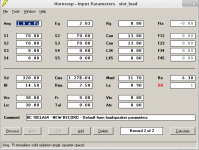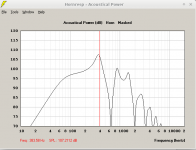now that you mentioned "fun" we are actually starting to talk the same language. So I encourage you to have even more fun by making speakers with these different drivers and by listening to them. But if making graphs is your cup of tea, please by all means. I just felt like putting the driver comparisons into a perspective. I will leave it at that now. thanks for listening.
Last edited:
Reproduktion as reproducing what the producer heard when mixing. Or maybe how the average good monitor sounds. On the others hand - Ive heard great sound from distorting and unlinear speakers/systems, so I agere that measurements are not everything. My life has an old Panasonic boomblaster that makes most recordings sound better than on a neutral setup
Cheers!
Cheers!
it is actually encouraging to see in the curves here that the industry seems to maintain a pretty good standard across different drivers and all of them could be expected to perform well within the intended freq range. I mean when you see in the old ISO standard that for obtrusive tonal noise it is recommended to be 17dB or better under the broadband noise, then 30 to 40dB down from a pure tone is pretty good for something that is meant to move air down to say 100-200Hz range.
Now what makes a particular driver make for a pleasant vocal presentation for example: that is everybody's guess. That is why I pay attention to subjective comments from people who heard a lot of speakers. So when Troels G. comments about a cheap peerless driver like this: "all in all these drivers make me wonder why I ever spend money on "the high-end" drivers. These NOMEX drivers have an excellent midrange presentation and if you're seeking a driver that will handle vocals and piano notes with grace, try out these drivers. I was pleasantly surprised."; then I see Joe R. using the same driver for the first iteration of Elsinores and people coming back with the same impressions; that prompts me to decide to make that speaker to hear for myself. Past that I may only try minor tweaks like pairing the speakers with a right amp, tuning the amp distortion and maybe changing tweeter attenuation if the amp starts emphasizing it etc. It IS a fun hobby and there are many approaches to a personal nirvana.
We do not see much here on the forum in the way of speaker designs using 10inch midbasses but hopefully after this thread there might be more?
Now what makes a particular driver make for a pleasant vocal presentation for example: that is everybody's guess. That is why I pay attention to subjective comments from people who heard a lot of speakers. So when Troels G. comments about a cheap peerless driver like this: "all in all these drivers make me wonder why I ever spend money on "the high-end" drivers. These NOMEX drivers have an excellent midrange presentation and if you're seeking a driver that will handle vocals and piano notes with grace, try out these drivers. I was pleasantly surprised."; then I see Joe R. using the same driver for the first iteration of Elsinores and people coming back with the same impressions; that prompts me to decide to make that speaker to hear for myself. Past that I may only try minor tweaks like pairing the speakers with a right amp, tuning the amp distortion and maybe changing tweeter attenuation if the amp starts emphasizing it etc. It IS a fun hobby and there are many approaches to a personal nirvana.
We do not see much here on the forum in the way of speaker designs using 10inch midbasses but hopefully after this thread there might be more?
Last edited:
We do not see much here on the forum in the way of speaker designs using 10inch midbasses but hopefully after this thread there might be more?
Mine soon : Tad ts-W252PRS sub; B&C 10nw76 midbass; SB acoustics MD60N-6 mid and Wavecor tw022wa09 tweeter
You want 130dB@1m continuous from one 10" driver??? Good luck!The SPL target for my next 'small' PA top is a continuous 130dB/1m (without blowing up, not low distortion at this level).
The B&C 10NW76 can deliver continuous peaks of 126dB at one meter (+20dB over the roughly 10 watt distortion test level above) without exceeding it's 800 watt "continuous" rating.
It's distortion would be considerably more than at a level 20dB less, and depending on the crest factor of the program, the peak level would begin to fade due to voice coil heating impedance rise ("thermal compression") after continuous use.
Thermal compression is an important consideration for high power use, the difference between drivers rated in the 800 watt range may vary more than 3dB, unfortunately low power testing won't reveal that difference, got to get to "war" levels for that ;^).
That said, from my experience with B&C drivers, I'd bet on the 10NW76 to be near the top in the "war of the 10" monster midbasses" regarding heat management.
Art
It's distortion would be considerably more than at a level 20dB less, and depending on the crest factor of the program, the peak level would begin to fade due to voice coil heating impedance rise ("thermal compression") after continuous use.
Thermal compression is an important consideration for high power use, the difference between drivers rated in the 800 watt range may vary more than 3dB, unfortunately low power testing won't reveal that difference, got to get to "war" levels for that ;^).
That said, from my experience with B&C drivers, I'd bet on the 10NW76 to be near the top in the "war of the 10" monster midbasses" regarding heat management.
Art
I intend on using two (+6dB) and they will also be slot loaded which increases efficiency over part of their frequency range but perhaps 'quasi continuous' would be a better description. I.E witin the thermal time constant of the magnet but not the thermal time constant of the voice coil.You want 130dB@1m continuous from one 10" driver??? Good luck!
I didn't know about slot loading before. My search found this, do you want to build it following this principle? Then I may have a suggestion for a possible small improvement... but the article also contains a passage that indirectly questions PA use to some degree.
Last edited:
More like a 6th order bandpass box with a very small front chamber. Attached is a very basic Hornresp sim (without rear chamber venting so 4th order) showing the general idea*. In the actual application I would use volume filling plugs so it would be a bit more complex. I generally ignore Nelson Pass articles I'm not the intended audience 
*This speaker is triamp and using FIR filtering so its intended to 'fix' the group delay spikes caused by this method.
*This speaker is triamp and using FIR filtering so its intended to 'fix' the group delay spikes caused by this method.
Attachments
I did some quick and dirty experiments with slot loading a 8PE21 - it brings some gain and improves directivity (https://www.diyaudio.com/community/threads/3d-printed-audio-stuff-with-stl-files.349459/post-6122255)
Sorry, IMHO this does not look useful at all. Or do you want to use only the peak around 400Hz?More like a 6th order bandpass box with a very small front chamber. Attached is a very basic Hornresp sim.
Maybe I still don't understand it all...
this is the idea but it has evolved a bit in that there are now cavities in front of the side woofers that are only open on the front face. The peak is great news as it reduces power dissipation when equalized out. The 10" is only going to cover a limited frequency range 100Hz - 300/400Hz (this is only a rough idea I haven't done that much simulation work yet).Sorry, IMHO this does not look useful at all. Or do you want to use only the peak around 400Hz?
Maybe I still don't understand it all...
https://www.diyaudio.com/community/threads/compact-3-way-pa-90x60-speaker-meh-side-woofers.367253/
It might also help to explain I dislike metal grills so reducing their size or eliminating them in speaker designs is a big plus for me.
Martin Audio has used slot-loading throat adapters on short horns for a very long time. Their latest boxes port the rear chamber. Here's a close up of the 10-inch LF section of the MLA Compact, which is a hypex horn with a low value for flare-rate, T:

Forgive the large size of the image, but I thought it best to make sure you can see the cone clearly.
Forgive the blurriness, but this is the published 2.83 V sensitivity on-axis (white trace), and at a few 10-degree horizontal offsets.


You can perhaps see what's going on a little better in the bigger brother MLA box, which uses dual 12" in a shared rear chamber, rather than two 10" with their own separate chambers. The 10" version doesn't have the bend, but both of them are crossed in the 300-400 Hz region to the mid-range elements using 4th order slopes as shown on the transfer function plot above. I'm pretty sure both of these boxes also use B&C drivers for the LF section.

I believe the use of the slot evens out the pressure across the diaphragm, while also increasing the compression ratio. The horn itself seems to be explicitly 'cut short' to trade loading at the lower cutoff for more output in the vocal region and optimised using BEM to reduce the resulting ripple in the acoustic impedance.
Forgive the large size of the image, but I thought it best to make sure you can see the cone clearly.
Forgive the blurriness, but this is the published 2.83 V sensitivity on-axis (white trace), and at a few 10-degree horizontal offsets.
You can perhaps see what's going on a little better in the bigger brother MLA box, which uses dual 12" in a shared rear chamber, rather than two 10" with their own separate chambers. The 10" version doesn't have the bend, but both of them are crossed in the 300-400 Hz region to the mid-range elements using 4th order slopes as shown on the transfer function plot above. I'm pretty sure both of these boxes also use B&C drivers for the LF section.
I believe the use of the slot evens out the pressure across the diaphragm, while also increasing the compression ratio. The horn itself seems to be explicitly 'cut short' to trade loading at the lower cutoff for more output in the vocal region and optimised using BEM to reduce the resulting ripple in the acoustic impedance.
- Home
- Loudspeakers
- Multi-Way
- War of the 10" monster midbasses

